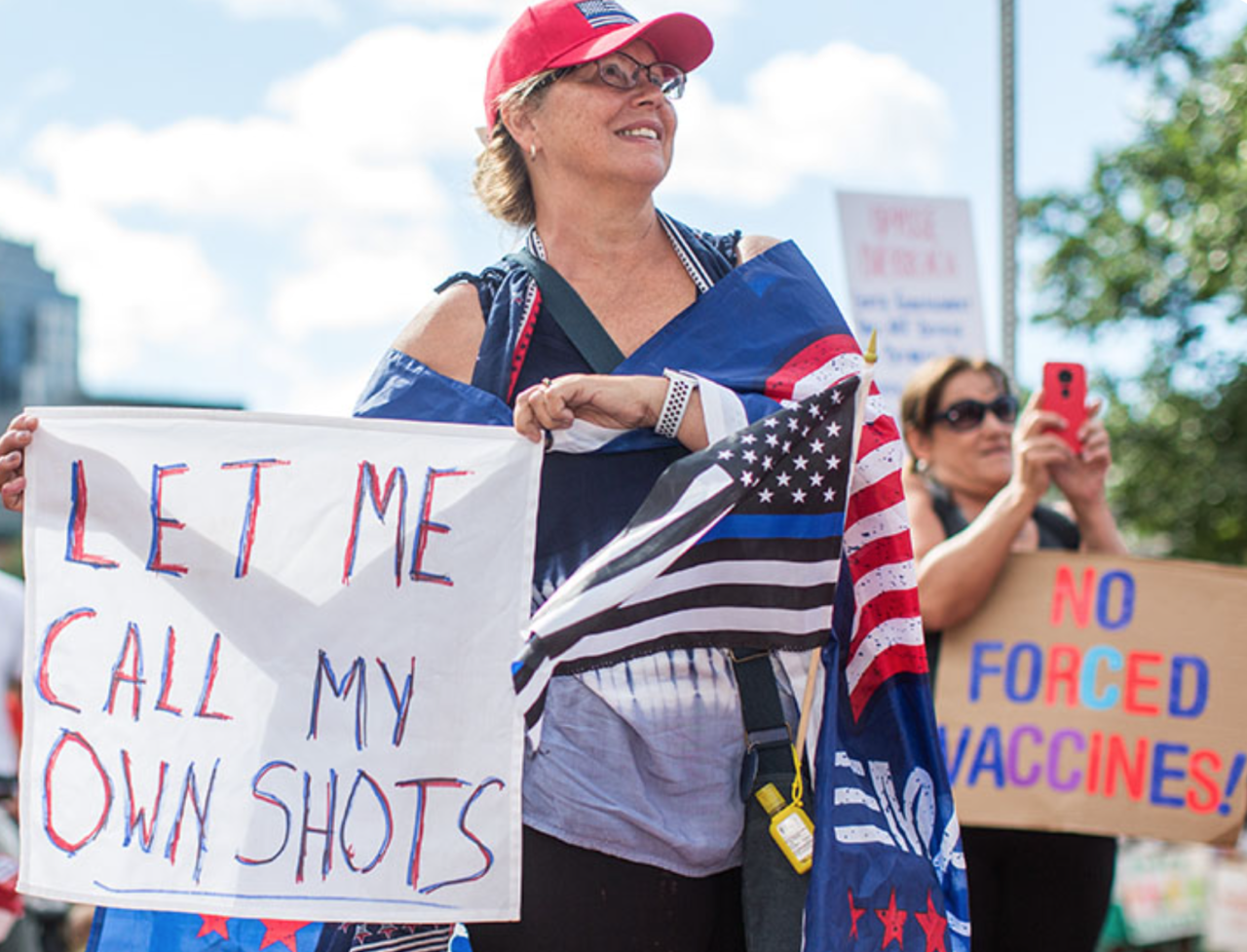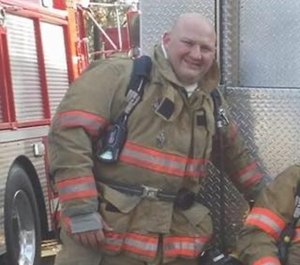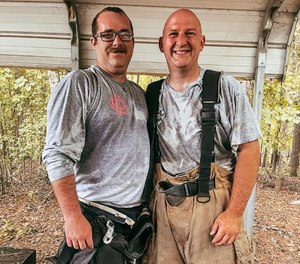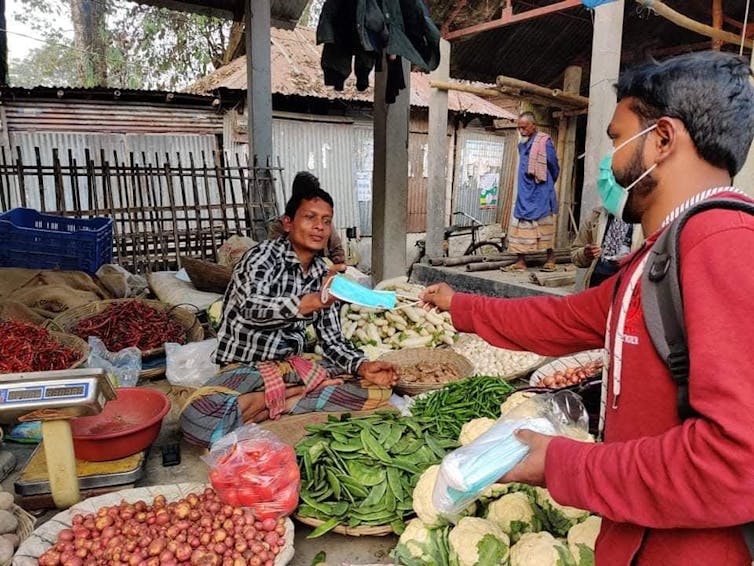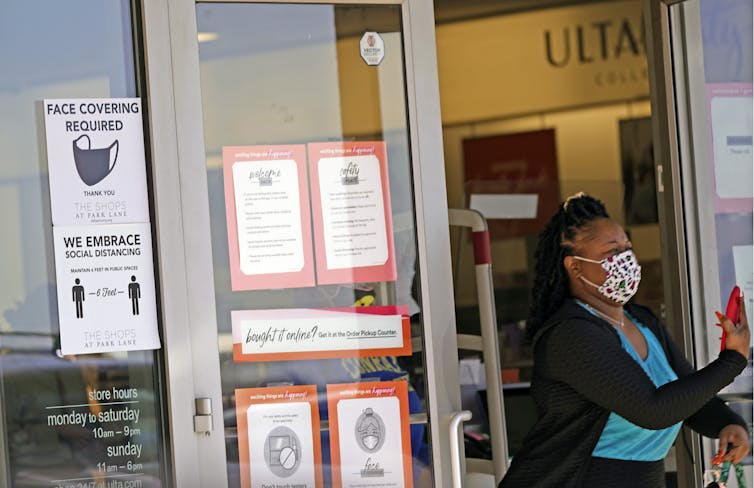Since the Omicron variant was discovered four weeks ago, epidemiologists have been crunching data as fast as scientists on the front lines can produce it to scope out what the newest coronavirus variant means for the pandemic this winter beyond. While many uncertainties remain, disease modelers have cranked out several potential visions for what the first months of 2022 may have in store. Worst case — they could bring the deadliest phase of the pandemic yet. But even the most optimistic scenarios aren’t exactly pretty.
Which immediate future plays out will be a function of a few big unknowns — some already baked into Omicron’s biology and some that can be altered based on how people behave in the coming days and weeks. Further out, the models get fuzzier still. But though they differ in the details, all of them point to SARS-CoV-2 being here to stay.
“I think we may be in for a longer road than we had hoped,” said Jeffrey Shaman, an infectious disease forecaster at Columbia University’s Mailman School of Public Health.
What’s obvious about Omicron is its record-setting spread. Harder to grasp is the extent to which it is intrinsically more contagious than previous variants, versus the extent to which it’s simply better at infecting vaccinated and previously infected individuals.
In a preprint published this week, Shaman and his colleague Wan Yang tried to disentangle these two dynamics using data from South Africa, where the variant was first discovered. They found Omicron to be only about 35% more transmissible than Delta, a departure from the going estimate of twice to five times as infectious. The takeaway? The researchers believe that the majority of South Africans had been infected with SARS-CoV-2 before the Omicron wave, meaning the rapid spread was due more to the variant’s ability to erode the immunity conferred by previous infections or vaccines.
“That’s not something that should apply directly to other countries, like the U.S., because it’s very specific to the South African context,” said Shaman. Different strains took off there, leading to an immunological history not as relevant to the Northern Hemisphere. “How much immune erosion we can expect here will be hard to say,” said Shaman. “However, we’re talking about large numbers, so we could imagine it’s going to be pretty potent at running by the immunity of people who’ve already been infected or vaccinated in most places it shows up.”
That could be a recipe for the Omicron surge being the most devastating one yet. In one of the most comprehensive forecasts to date, researchers from the Covid-19 Modeling Consortium at the University of Texas, Austin, played out 18 different scenarios for how the new variant might hit the U.S.
In the report, which has not been peer-reviewed, the worst outcome arose when the researchers assumed Omicron to be no more transmissible than Delta but far better at evading immunity and more likely to cause severe disease — meaning requiring hospitalization. Combined with low booster uptake, this scenario resulted in cases peaking in early February, resulting in 342,000 deaths over the first six months of the year, a 20% spike over Covid-19 casualties in 2021.
In the most optimistic outcome — which assumes high transmissibility relative to Delta, little ability to evade immunity, slightly elevated severity, and high booster uptake — the researchers project the Omicron spike to lead to 50% fewer deaths compared to last year.
“Across all scenarios we expect to see cases that are at least as high as the Delta surge in September 2021, but that would be the minimum,” said Lauren Ancel Meyers, director of the UT Covid-19 Modeling Consortium. “At a maximum we could see a surge in cases that is even higher than our January 2021 surge, which would make it the biggest national surge seen to date.”
Whether these surges lead to equally calamitous casualties hinges hugely on that question of severity, an issue that has remained murky for weeks. On Wednesday, however, three separate teams of researchers, tracking Omicron’s advance through South Africa, Scotland, and England, reported new findings that suggesting the variant was less likely than Delta to send people to hospitals. Though preliminary, these studies are providing an injection of optimism that the worst-case scenarios won’t come to pass.

Looking overseas for clues
In South Africa, where the Omicron infection wave went steeply up and then sharply back down, particularly in Gauteng province, the peak of hospitalizations looks to be about half of the previous Delta wave. Deaths and ICU admissions appear even lower.
“That initial coming in really hot … is really scary, but what we saw in Gauteng, of its kind of crashing early, gives some hope here,” said computational biologist Trevor Bedford of the Fred Hutchinson Cancer Research Center, who was among the first U.S. experts to sound the initial alarm on SARS-CoV-2.
It’s a tricky thing though, to extrapolate the shape of that curve from South African provinces like Gauteng because the populations there look very different from either Europe or the U.S. People there tend to be younger, and therefore less prone to serious disease than in the U.S., where the population skews older and sicker, with more comorbidities like heart disease and diabetes. Another difference is that in South Africa, Omicron was a standalone surge. In contrast, here Omicron is hitting on top of Delta surges in the Northeast and Midwest, compounding the strain on health care systems.
Bedford is keeping an eye on London, where infections have exploded in recent days. Even by conservative estimates of detection rates, 1% of London is getting infected every day. That’s a big number. And even if the risk of hospitalization may be substantially lower per individual — a new analysis suggests that might be the case — that many infections would be markedly disruptive to society and to the functioning of health care systems. “So it really matters when that crests,” said Bedford. “If it crashes as early as it did in Gauteng, then it’s not so bad. But if it gets past that, then things get bad pretty quickly.”
Since Friday, Meyers’ team has updated its forecasts based on the increasing evidence that Omicron is becoming dominant in the U.S. even faster than expected. The researchers will continue to do so as more and better data on the severity question come in. But given how rapidly Omicron is advancing, the peak might arrive before firm answers do. Especially if a “less severe” narrative begins to take hold and people’s behaviors don’t change.
“Even in our most optimistic scenarios, the numbers are already surging to such high levels that we’re worried about what’s to come in the next couple of weeks in our hospitals,” said Meyers.
The models might be noisy; assumptions and uncertainties abound when data is sparse, which happens when a new variant emerges. But they’re better than nothing. And right now, they’re telling us we’ve entered a high-risk period, said Meyers. “So if ever there was a time to err on the side of caution, it’s now,” she said. “If we all tap the brakes a little bit right now, that can help us to protect the integrity of our health care system and also prevent us from really having to slam on the brakes at some point in the future.”

‘A viral blizzard.’
On Tuesday, President Biden announced steps the White House is taking to curb Covid-19 as Omicron overtakes Delta, which was already causing 115,000 daily new infections at the beginning of December. Those steps included delivering 500 million at-home rapid tests to households, starting in January, and urging Americans to get vaccinated and boosted. “Your choice can be the difference between life and death,” Biden said.
The administration also announced it would deploy some 1,000 military doctors, nurses, and medics to support hospitals, as well as activate pop-up vaccination and testing units run by the Federal Emergency Management Agency. Some public health experts say it’s not enough to deal with the coming body blow to the American health care system.
“All of the surges we’ve had to date have been regional and time-limited in a way that meant you could allocate resources from one place to another as needed,” said Michael Osterholm, director of the University of Minnesota’s Center for Infectious Disease Research and Policy. When the first wave of 2020 slammed New York City, other states sent ventilators and personal protective equipment. Later that summer, supplies were shuttled to Florida and other southern states feeling their first surge. And on through 2021 as northern states felt the worst of the winter wave, and the south got smacked with Delta this past summer. But SARS-CoV-2 has never walloped everywhere all at once.
“We’re going to be in a viral blizzard nationwide these next two to eight weeks, and the impact of this perfect storm is going to be felt hardest by our health care systems,” said Osterholm. “It could very well represent the darkest days of the pandemic.”
The U.S. currently employs about 9.8 million doctors, nurses, and high-level medical technicians. Omicron’s ability to erode protections from vaccination and prior infections means that at least 10% of those health care workers are likely to become infected and have to isolate, even if their symptoms are mild. “That’s 900,000 people off the job at a time when we’re already hanging on by the skin of our teeth as it is,” said Osterholm. “The president’s plan does not really address that problem.”

A worldwide wave
It’s not just the U.S. being hit in every state simultaneously. For the first time since the start of the pandemic, modelers are expecting a rapid surge all over the world.
On Wednesday, the University of Washington Institute for Health Metrics and Evaluation released new projections, showing approximately 3 billion infections globally between now and the end of February. “We believe it will reach all countries quite soon,” the institute’s director, Chris Murray, told reporters at a briefing.
If the numbers are to be believed — critics have previously assailed the institute’s Covid-19 modeling as unreliable — then we’re talking about two years’ worth of infections cresting in the next two months. Murray’s team is projecting comparatively modest deaths during that staggering surge, fewer than the number caused by Delta, owing to a vast number of the infections being mild or asymptomatic. But stealth spread coupled with Omicron’s rapid replication rate causes other sorts of problems; traditional public health strategies like testing, contact tracing, isolation, and quarantine start to fall apart.
“There’s just not enough time to detect infections and act on that information,” said William Moss, executive director of the International Vaccine Access Center at the Johns Hopkins Bloomberg School of Public Health. That means even countries who’ve had very few cases, like New Zealand and many small Pacific Islands, may have a hard time holding off Omicron.
China, where most citizens have received either the Sinopharm or Sinovac shots, is particularly vulnerable to major disease and disruption. Both vaccines have shown particular weakness against Omicron in preliminary lab studies. Strict lockdowns in areas where many countries still outsource production of many pharmaceuticals and medical supplies could lead to new and more severe rounds of shortages.
“As countries experience surges, there’s going to be demand within those countries for a whole range of products and treatments, which limits the ability to get those to other countries that lack the manufacturing capacity themselves,” said Moss. “This pandemic, over and over, has exacerbated these inequalities, and a huge global surge will place the low-income and most vulnerable countries at a disadvantage yet again.”
He also worries about the long-term knock-on effects of massive disruptions to already fragile health care systems. Huge waves will likely mean pausing other medical services, like malaria and tuberculosis prevention, care for chronic disease patients, and routine childhood immunization. “I’m very afraid of huge measles outbreaks in the next year or two, particularly in sub-Saharan Africa,” said Moss. “We could be seeing ripple effects of Omicron for years.”

The long view
The newest variant has also inexorably altered the course of the pandemic. Although it’s still unclear how high and how fast the curves will climb (and how many people will get very sick or die in the process), Murray said when he and his team run their models further out, they see Covid-19 quieting down for much of 2022. “The thing Omicron will do because it’s going to infect 40% of the entire world in the next two months, is it will raise population-wide immunity for a while,” he said. After a massive Omicron wave passes through, transmission should drop to very low levels. Ongoing rollouts of vaccines should help keep it that way.
But forecasting is hard and gets harder the further out you go. And the one big caveat to every far-out-future scenario is how the coronavirus will evolve next. “The long-term prospects for 2022 and beyond are very much a function of what the next variant that comes along shows,” said Murray.
Next year should see the scaling-up of antiviral production, he also pointed out. As future variants drive new waves in infections, the wide availability of these treatments — especially Pfizer’s newly authorized pill, which the company expects to make 120 million courses of in 2022, should blunt hospitalizations and deaths further.
“We would be in a different place, at least temporarily, at the end of the current surge than we’ve been at any point since the beginning of the pandemic,” said UT’s Meyers.
The result could be something that starts to look like SARS-CoV-2 becoming an endemic coronavirus and joining a quartet of more ancient, cold-causing cousins. As Bedford has suggested, we might look back on the Omicron surge as the last wave of the pandemic. If, after all the dust settles, Omicron does turn out to cause milder disease, then its world domination could turn out to be a good thing in the very grand scheme of things.
But between variant evolution and waning immunity, that’s not to say the virus won’t still lead to significant casualties in that endemic future. “I could still easily imagine 100,000 people [in the United States] dying every year from Covid in the endemic state just because you have a very big number of infections, even if the infection fatality rate is quite low,” Bedford told STAT. In 2020, 385,000 Americans died from Covid-19, according to data collected by the CDC. By November of this year, deaths associated with Covid-19 in 2021 had already surpassed that.
But guessing where exactly the next variant will arise and what problematic properties it will have is pretty much impossible, even for the sharpest Covid minds. Back in September, Bedford predicted that whatever came next would almost certainly be a twist of the then-dominant variant, Delta. But then Omicron materialized almost out of nowhere — its closest evolutionary relatives versions of the virus not seen since summer of 2020, leading some scientists to hypothesize that it might have come from an animal host.
If it could happen with Omicron, it could certainly happen again. SARS-CoV-2 is what’s known as a promiscuous virus. It gets around, and not just in humans. Scientists have found it in dogs and house cats. Tigers and lions. Gorillas. Mink. And it’s really taken off in whitetail deer.
Last month, researchers reported that up to 40% of deer populations in Illinois, Michigan, Pennsylvania, and New York had antibodies to the coronavirus. Another group found active SARS-CoV-2 infections in at least 30% of deer tested across Iowa in 2020. The findings suggest that the animals could become a long-term reservoir: a safe haven where the virus can circulate and evolve indefinitely, spilling back mutated versions of it to humans from time to time. While the virus doesn’t have an infinite capacity to mutate — it still needs to be able to bind to human receptors to get into our cells — this promiscuity will certainly complicate efforts to manage SARS-CoV-2 in the coming years and decades. And yes, you heard that right: decades.
“Whether or not it becomes endemic in six months or a year or five years from now, this virus is sticking around on Planet Earth, probably forever,” said Jeremy Kamil, a virologist at Louisiana State University Health Shreveport. “As long as humans and animals and rodents are around, it will continue to evolve and change and probably won’t be the threat it is today, but it’s not going away.”
Even if we accept that permanence, we still hunger to see around the corner. At the beginning of the pandemic, Osterholm and his colleagues attempted to predict its future course, using historical influenza pandemics as a guide. As STAT’s Sharon Begley wrote at the time, they envisioned three possible futures: a monster-wave followed by mini-waves every few months with placid times between, recurring small outbreaks, and constant crisis. What we’ve had in reality is something that doesn’t look exactly like any of these.
In the United States, SARS-CoV-2 was never really brought under control, so the successive viral surges of spring, then summer, then winter of 2020 weren’t really waved so much as humps in an ever-building coronavirus current. Vaccines brought a precipitous drop in the first few months of 2021, but then Delta emerged, and then Omicron, and now 2021 is looking like 2020 again, but bigger, with even more infectious energy behind it.
“At the time, we had no way to understand the power of these variants,” said Osterholm. “What has made this such a challenging pathogen to predict is that its mutational changes are really different than what we see with the flu virus. We thought it would behave somewhat like influenza, but it’s turned out to be a very different animal.”
Helen Branswell contributed reporting.
Correction: An earlier version of this story misstated Trevor Bedford’s view on when SARS-CoV-2 will enter the endemic phase. He says it will reach that point next year, after the Omicron wave.

